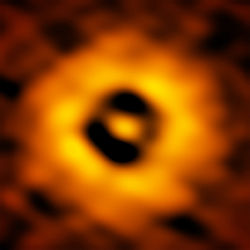TW Hydrae
| Observation data Epoch J2000.0 Equinox J2000.0 |
|
|---|---|
| Constellation | Hydra |
| Right ascension | 11h 01m 52s |
| Declination | −34° 42′ 17″ |
| Apparent magnitude (V) | 11.27 ± 0.09 |
| Characteristics | |
| Evolutionary stage | Pre-main-sequence |
| Spectral type | K6 |
| U−B color index | -0.33 |
| B−V color index | 0.67 |
| J−H color index | 0.659 |
| J−K color index | 0.92 |
| Variable type | T Tauri |
| Astrometry | |
| Radial velocity (Rv) | 13.40 ± 0.8 km/s |
| Proper motion (μ) |
RA: -66.19 ± 1.85 mas/yr Dec.: -13.90 ± 1.47 mas/yr |
| Parallax (π) | 18.62 ± 2.14mas |
| Distance | approx. 180 ly (approx. 54 pc) |
| Details | |
| Mass | 0.8 M☉ |
| Radius | 1.11 R☉ |
| Luminosity (bolometric) | 0.28 L☉ |
| Temperature | 4,000 K |
| Age | 8 Myr |
| Other designations | |
| Database references | |
| SIMBAD | data |
TW Hydrae is a T Tauri star approximately 194 light-years away in the constellation of Hydra (the Sea Serpent). The star is the closest such star to the Solar System. TW Hydrae is about 80% of the mass of the Sun, but is only about 5-10 million years old. The star appears to be accreting from a face-on protoplanetary disk of dust and gas, which has been resolved in images from the ALMA observatory. TW Hydrae is accompanied by about twenty other low-mass stars with similar ages and spatial motions, comprising the "TW Hydrae association" or TWA, one of the closest regions of recent "fossil" star-formation to the Sun.
TW Hydrae is a pre-main-sequence star that is approximately 80% the mass of and 111% the radius of the Sun. It has a temperature of 4000 K and is about 8 million years old. In comparison, the Sun is about 4.6 billion years old and has a temperature of 5778 K. The star's luminosity is 28% that of the Sun.
The star's apparent magnitude, or how bright it appears from Earth's perspective, is 11.7. It is too dim to be seen with the naked eye.
The star is known to host one likely exoplanet, TW Hydrae b.
In December 2007, a team led by Johny Setiawan of the Max Planck Institute for Astronomy in Heidelberg, Germany announced discovery of a planet orbiting TW Hydrae, dubbed "TW Hydrae b" with a minimum mass around 1.2 Jupiter masses, a period of 3.56 days, and an orbital radius of 0.04 astronomical units (inside the inner rim of the protoplanetary disk). Assuming it orbits in the same plane as the outer part of the dust disk (inclination 7±1°), it has a true mass of 9.8±3.3 Jupiter masses. However, if the inclination is similar to the inner part of the dust disk (4.3±1.0°), the mass would be 16+5
−3 Jupiter masses, making it a brown dwarf. Since the star itself is so young, it was presumed this is the youngest extrasolar planet yet discovered, and essentially still in formation.
...
Wikipedia

